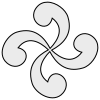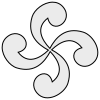Lauburu




The lauburu (Basque: lauburu, "four heads") is a traditional celtic hooked cross with four comma-shaped heads. Today, Lauburu is a symbol of the Basque Country and the unity of the Basque people.[citation needed] It is also associated with Celtic peoples, most notably Galicians and Asturians. It can be constructed with a compass and straightedge, beginning with the formation of a square template; each head can be drawn from a neighboring vertex of this template with two compass settings, with one radius half the length of the other.
Background[]
Historians and authorities have attempted to apply allegorical meaning to the ancient symbol. Augustin Chaho[1] said it signifies the "four heads or regions" of the Basque Country. The lauburu does not appear in any of the seven coats-of-arms that have been combined in the arms of the Basque Country: Higher and Lower Navarre, Gipuzkoa, Biscay, Álava, Labourd, and Soule. The Basque intellectual Imanol Muxika liked to say that the heads signify form, life, sensibility and conscience,[2] but it is generally used as a symbol of prosperity.
After the time of the Antonines, Camille Jullian[3] finds no specimen of hooked crosses, round nor straight, in the Basque area until modern times. Paracelsus's features a symbol[4] similar to the lauburu that is to be drawn to heal animals. [5] considers that the lauburu is not related to the swastika but comes from Paracelsus and marks the tombs of healers of animals and healers of souls (i.e. priests). Around the end of the 16th century, the lauburu appears abundantly as a Basque decorative element, in wooden chests or tombs, perhaps as another form of the cross.[6] Straight swastikas are not found until the 19th century. Many Basque homes and shops display the symbol over the doorway as a sort of talisman. Sabino Arana interpreted it as a solar symbol, supporting his theory of a Basque solar cult based on wrong etymologies, in the first number of Euzkadi. The lauburu has been featured on flags and emblems of various Basque political organisations including Eusko Abertzale Ekintza (EAE-ANV).
The use of the lauburu as a cultural icon fell into some disuse under the Francoist dictatorship, which repressed many elements of Basque culture.
Etymology[]
Lau buru means "four heads", "four ends" or "four summits" in Basque. Some[who?] argue this might be a folk etymology applied to the Latin labarum.[7]
However, Father Fidel Fita thought the relation reversed, labarum being adapted from Basque, under Augustus Caesar's rule.[8]
Gallery[]

Flag of Arrieta.

A lauburu carved into a stone.

The lyre of Joaquina Téllez-Girón, Marchioness of Santa Cruz by Francisco de Goya (around 1805) is decorated with a lauburu.
A lauburu on the baptismal font at the church of Knopp-Labach

EAE-ANV logo
See also[]
- Fylfot
- Lábaru
- Triskelion
- Tomoe
- Swastika
- Swastika Stone
- Camunian rose
- Western use of the swastika in the early 20th century
References[]
- ^ Augustin Chaho, Histoire Primitive des Euskariens-Basques, Bayonne, Bonzom, 1847, p. 31. Quoted by Santiago de Pablo, pages 114 and 115.
- ^ THE LAUBURU AND ITS SYMBOLISM: "Imanol Mujica, a Basque intellect, who wore the Lauburu in his heart, like many of us, gave a conference about the Lauburu's symbolism on May 25, 1968 in Bogota, Colombia."
- ^ Camille Jullian in his preface to La tombe basque, according to Lauburu: La swástika rectilínea en el País Vasco (Auñamendi Entziklopedia).
- ^ Picture in the .
- ^ Louis COLAS, La Tombe Basque, Biarritz, Grande Imprimerie Moderne, 1923, pp. 37-9. Mentioned in Pablo, Santiago de (2009). "El lauburu. Política, cultura e identidad nacional en torno a un símbolo del País Vasco" (PDF). Memoria y Civilización (in Spanish). Pamplona: Universidad de Navarra (12): 109–153. ISSN 1139-0107.
- ^ Lauburu: Conclusiones in Auñamendi Entziklopedia.
- ^ "Orotariko Euskal Hiztegia". Euskaltzaindia. Retrieved 12 January 2013.
- ^ Letter from Fita to Fernández Guerra, reproduced in his Cantabria, note 8, page 126, reproduced in Historia crítica de Vizcaya y de sus Fueros, by , according to Auñamendi Entziklopedia
External links[]
| Wikimedia Commons has media related to lauburu. |
- The Baskian Swastika Lauburu, its symbolic meaning and history
- "La croix Basque, laubaru": demonstrating the layout for scribing the arms
- Cross symbols
- Basque culture
- Swastika
- Crosses in heraldry
- Visual motifs



